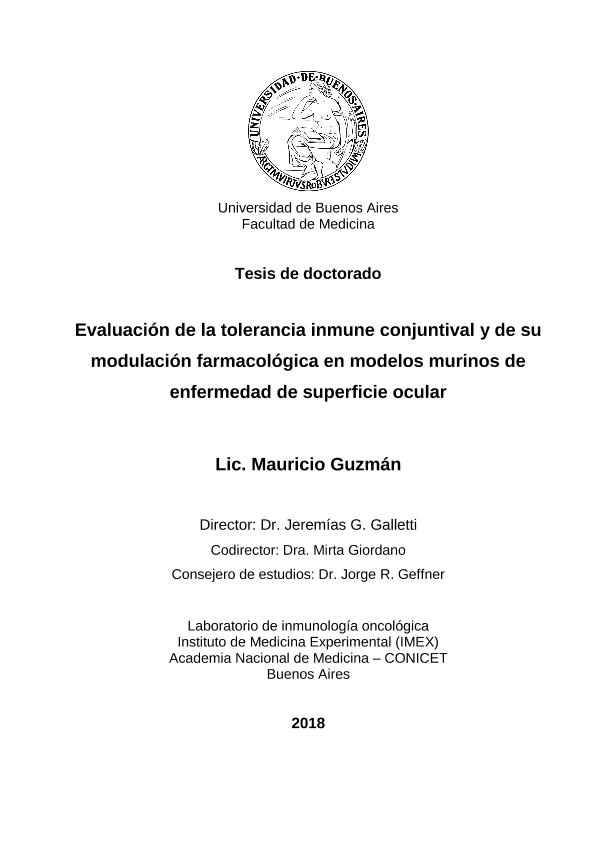Tesis doctoral
El ojo es el órgano que representa la base del sistema de la visión y su complejidad e importancia requieren una protección de magnitud acorde con el órgano mismo. En este sentido, la tolerancia inmune inducida por la mucosa conjuntival es el principal mecanismo de defensa de la superficie ocular, ampliamente estudiado en condiciones de homeostasis. Sin embargo, aún no se había determinado su importancia en el desarrollo de enfermedades. Por esta razón, en este trabajo de tesis, planteamos que la alteración de la tolerancia inmune podría estar favoreciendo la fisiopatología de dos enfermedades diferentes de la superficie ocular.En la primera parte estudiamos la enfermedad de ojo seco, un trastorno autoinmune para el cual los mecanismos iniciadores siguen siendo desconocidos. El estrés de desecación se considera un factor potenciador, y la hiperosmolaridad lagrimal se observa con frecuencia en los pacientes, pero su contribución a la enfermedad no ha sido resuelta. Usando diferentes modelos murinos, encontramos que el estrés de desecación y la película lagrimal hiperosmolar, de forma independiente, causan la pérdida de tolerancia inmune hacia un antígeno exógeno a través de un mecanismo dependiente de la activación epitelial de NF-κB. Además, la inhibición tópica de NF-κB redujo las condiciones proinflamatorias, impidió la alteración de la tolerancia y como consecuencia, mejoraron las condiciones clínicas. Esto destaca que la pérdida de tolerancia de la mucosa juega un rol primordial en la patogénesis del ojo seco y sugiere que la inactivación de NF-κB en la mucosa podría tener potencial terapéutico.En la segunda parte, estudiamos el efecto de una lesión corneal unilateral sobre el comportamiento inmune de la mucosa conjuntival. A partir de un modelo murino, observamos que la tolerancia inmune hacia un antígeno exógeno estaba alterada en el ojo lesionado, pero sorprendentemente, también se alteró en el ojo contralateral sano. Se ha informado la interdependencia inmunológica de los dos ojos para la córnea y la retina, pero no para la mucosa. Reportamos que, ante la falta de drenaje linfático cruzado, existe un arco reflejo neurogénico que comunica ambos ojos. Identificamos a TRPV1 como el receptor que detecta daño tisular en el ojo lesionado y la sustancia P liberada en el ojo contralateral como el efector de la respuesta simpática inflamatoria. Además, el bloqueo del arco reflejo previno las reacciones alérgicas posteriores. Finalmente, concluimos que ambas superficies oculares están inmunológicamente vinculadas y sugerimos potenciales dianas terapéuticas para la intervención. The eye is the organ that represents the vision and its complexity and importance imply a protection of as much magnitude as the organ itself. In this sense, the immune tolerance induced by the conjunctival mucosa is the main defense mechanism of the ocular surface, widely studied in conditions of homeostasis. However, its importance in the development of diseases has not yet been determined. For this reason, we propose that the alteration of the immune tolerance could be favoring the physiopathology of two different diseases of the ocular surface. In the first part, we study dry eye disease, an autoimmune disorder for which the initiating mechanisms remain unknown. Desiccation stress is considered an enhancing factor, and the hyperosmolar tear film is frequently seen in patients, but its contribution to the disease has not been resolved. Using different murine models, we found that the desiccation stress and the hyperosmolar tear film, independently, cause the NF-κB - and time - dependent disruption of the ocular surface's immune tolerance to exogenous antigen. In addition, topical NF-κB inhibition reduced proinflammatory conditions, prevented the alteration of mucosal tolerance and as a consequence, improved clinical conditions. This highlights that the disruption of the ocular surface's immune tolerance plays a major role in the pathogenesis of dry eye. Considering this, we suggest that the NF-κB inactivation in the mucosa could have therapeutic potential to ocular surface's diseases treatment. In the second part, we studied the effect that a unilateral corneal injury causes on the immune mechanism of the conjunctival mucosa. From a murine model, we observed that the immune tolerance towards an exogenous antigen was altered in the injured eye, but surprisingly, it was also altered in the healthy contralateral eye. The immunological interdependence between the two eyes has been reported for the cornea and the retina, but not for the mucosa. We report that, despite the lack of crossed lymphatic drainage between both sides, there is a neurogenic reflex arc that communicates both eyes. We identified TRPV1 channel as the receptor sensing tissue damage in the injured eye and substance P released in the opposite ocular surface as the effector of the inflammatory sympathetic response. In addition, blocking of the neurogenic reflex arc prevented subsequent allergic reactions. Finally, we concluded that both ocular surfaces are immunologically linked and suggest potential therapeutic targets during surgical interventions.
Evaluación de la tolerancia inmune conjuntival y de su modulación farmacológica en modelos murinos de enfermedad de superficie ocular
Título:
Evaluation of conjunctival immune tolerance and the pharmacological modulation in murine models of ocular surface disease
Guzman, Mauricio

Director:
Galletti, Jeremías Gastón

Codirector:
Giordano, Mirta Nilda

Consejero de estudios:
Geffner, Jorge Raúl

Fecha de publicación:
26/09/2018
Idioma:
Español
Clasificación temática:
Resumen
Archivos asociados
Licencia
Identificadores
Colecciones
Tesis(IMEX)
Tesis de INST.DE MEDICINA EXPERIMENTAL
Tesis de INST.DE MEDICINA EXPERIMENTAL
Citación
Guzman, Mauricio; Galletti, Jeremías Gastón; Giordano, Mirta Nilda; Geffner, Jorge Raúl; Evaluación de la tolerancia inmune conjuntival y de su modulación farmacológica en modelos murinos de enfermedad de superficie ocular; 26-9-2018
Compartir



